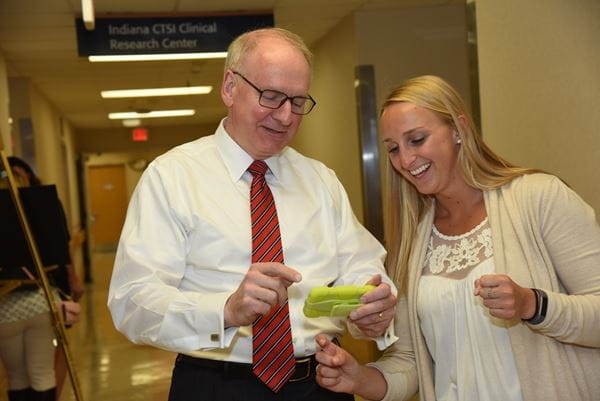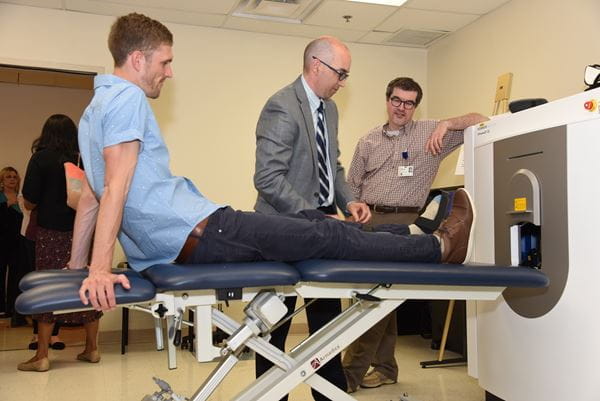Musculoskeletal health impacts numerous aspects of wellbeing but none more so than physical function. Musculoskeletal disease, injury and aging all produce questions of how people function under these varying, adverse circumstances. The ICMH FIT Core, which was formed in 2017, was designed to help answer these questions. Understanding a person’s physical function is simply a matter of testing their physical performance in everyday situations and comparing the results to their own past performance or the performance of others. These results, when looked at in conjunction with other measures of their physical makeup, can give physicians and researchers a solid understanding of how their patient is able to physically function in their day-to-day life. While this concept is simple, this type of data has not historically been incorporated with research.
Despite elements of this type of data collection existing at various places in the past, the FIT Core is unique in bringing these components under one unified domain. The Core is also novel in that the testing looks at both bone and muscle function, providing utility to a broad range of researchers. The FIT Core is so named to represent the three main mechanisms of the core’s methodology: Functional testing, bone and muscle Imaging and Tissue collection and biobanking. Participants that come through the Core spend 60 to 90 minutes performing a battery of physical function testing, receiving various imaging scans and providing a small biological sample. The results of these tests, the images taken and the tissue procured are then added to a single database and connected to patient medical records.
To get a better understanding of the impact the FIT Core has on research at IU, I sat down with Dr. Stuart Warden, PhD, the Core’s Director since it’s foundation. Dr. Warden is a Professor and the Associate Dean for Research within the School of Health and Human Sciences at IUPUI. His training as a physical therapist and experience with similar physical function testing and methodologies have served as the foundation of the Core’s creation and growth. It’s from that perspective that Dr. Warden provided the following insights.

First and foremost, will you talk a little about the importance of having a resource like the FIT Core in ultimately effecting, and hopefully improving, health outcomes within various patient populations?
The FIT Core was formed around the idea of providing investigators and clinicians resources to assess physical function in the context of other systemic conditions, such as disease or illness. Ultimately, the impact of an illness on a patient’s ability to function in their environment becomes the heart of the day- to-day challenges they face. We often see a cycle develop where an illness impacts physical performance which in turn creates a feedback loop making the illness worse.
Historically, research has tended to focus on the systemic diseases themselves and not the resulting functional limitations. Recently, however, there has been a concerted effort to recognize these cycles and their impact on the quality of life and mortality of patients. Data produced in the FIT Core can be used by clinicians and researchers to better understand the functional consequences of various illnesses and hopefully lead to interventions that produce better patient outcomes.
How are researchers currently using the FIT Core in their projects?
The Core is utilized by researchers in two main ways, which we call front-end and back-end. Front-end usage is when investigators or clinicians send their patients or volunteers through the core testing process and then use that data directly. Examples of this would be a clinician sending their patients through the FIT Core to look at the effect of different types of cancer on muscle performance. Another could be looking at how a group of subjects that previously tested positive for Covid-19 perform compared to baseline. One big advantage of using the Core for this type of research is the removal of regulatory burdens investigators would typically face when developing studies and grant applications. Since the FIT Core operates with uniform protocols and methodologies, PI’s don’t have to develop these for each individual project they’re working on.
The second way the Core is used, which we call the back-end, is exclusively looking at the data and samples we have warehoused. All of the data generated from the functionality testing and imaging is saved in a centralized database and all samples collected are banked. Notably, this data can also be linked to electronic medical records, which is an innovation in the field. Since the Core is funded by the NIH, all of the data collected is available to anyone and can be easily deidentified to protect patient and volunteer privacy.
By analyzing the data collected from past Core participants, we are able to answer specific questions posed by researchers, such as “what does performance look like in people with high levels of a specific molecule in their blood”. The data can also be used to form normative baselines which investigators can compare their own data to. The capability to provide this data makes the Core quite unique and affords researchers running clinical trails the ability to include “normals” to which they can compare their subjects. Those comparisons are not included in most clinical trials because the normative data simply isn’t available.
This back-end usage of the Core excels at identifying high level associations between specific factors and performance results which can then be used as proof of concept to develop larger studies. The Core’s data essentially acts as preliminary or pilot data, massively expediting external applications and leading to higher funding. The first few years the Core was operational, we weren’t able to do much of this back-end work because there had not been enough participants to provide useful data. However, as the database has grown, we now see this type of usage much more frequently. Making wide use of the Core’s data in this manner is a major goal moving forward.

Have you personally used the Core in your research?
I have used the FIT Core in my own research. On the front-end, I broadly looked at how bone responds to exercise and then used the data to answer specific questions in that area. I have also utilized the Core’s specialized CT scanner (used for research not medical diagnostics) to look at bone. I was then able to interpret those scan results to determine correlation, i.e. this number on a scan is correlated with this functional result. On the back-end, I have used the FIT Core to build and publish normative database for other researchers and clinicians to use.
How did you come to lead the FIT Core?
I’m trained as a physical therapist and have the expertise in the physical function testing necessary for a resource like this. I actually had a similar, though less formal, set up I previously used in pharmaceutical trials. That experience led to my appointment as Core Director.
On a more personal level, I have a great appreciation for the impact fitness and lifestyle have on physical function and health outcomes. My hope is that when people come through the core and look at their data it encourages them to become more active. Regardless of why a person comes through the FIT Core, if their participation becomes the stimulus for a positive change in their life, I consider that a huge win.
What kind of results, in terms of publications and external funding, have been generated based on data gathered by the FIT Core?
In general, having the FIT Core included as part of external applications has been seen as a strength, with reviewers always leaving very positive comments. It has also helped to include musculoskeletal outcomes in grant proposals that wouldn’t have been included otherwise. More specifically, the Core has been part of proposals that have secured over $7M in external funding. This is on top of more than 40 publications directly attributable to the Core.
Talk a little about the future of the Core. Where do you see opportunities for growth?
The first few years after launch were all about getting the Core operational and working out its niche. Since then, it has evolved substantially. We were able to create the physical space the Core now occupies in the IU Health University Hospital, but we would really like to reach out beyond those walls. Remote testing in other locations, such as the satellite testing now being done at Eskenazi Hospital, is a key focus area. Training other investigators on the methods used to perform the testing within the Core makes the benefits more transferable and drives growth, so that is also a priority moving forward.
Another very important goal to the future of the Core is increasing the diversity of our subjects, mainly in terms of racial and ethnic diversity and also gender diversity (we need more male subjects!). One way to drive this diversity of subjects is by really focusing on the community aspects of the Core. This could look like more people coming in off the street, who are interested in participating because they want to have a better understanding of their health or it could look like increasing engagement with physicians who can send their patients through the Core and use the data help determine performance capacity more holistically than simple vital signs and tests can.
One final avenue for future growth of the core is people beginning to come through the Core multiple times and comparing their results over time. This could also afford the opportunity to incorporate additional elements to the testing protocols, such as having subjects fill out a lifestyle questionnaire which could be used to track changes over time and how that impacts the subject’s testing results. There are many ways the Core can grow moving forward and we are very excited about all of the possibilities.
We highly encourage everyone to participate in going through the FIT Core as a subject. The ICMH FIT Core is located on the 5th floor of University Hospital, on the IUPUI Campus, in downtown Indianapolis. The Core is open to anyone 5 and older and of any physical fitness level or condition (don’t let the name scare you! The testing done at the core is not a fitness test). Participation is an excellent way for anyone to contribute to musculoskeletal research, while also getting a free DEXA Scan, something that would normally cost hundreds of dollars. If you would like to volunteer as a subject or discuss utilizing the core in the treatment of patients or in a research project please visit the FIT Core webpage for more information.
Written by Kyle Bone, ICMH Operations Manager
